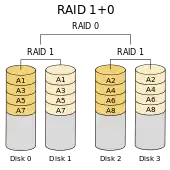We are planning to deploy a Microsoft SQL Server and to store the databases on a RAID10 (RAID1+0) block-level-storage.

Does it matter how many drives altogether I put into the array for optimum operation? Be it four, as in the picture above, or six or eight or ten?
I was told that I need the correct amount of drives to have an optimised block size for MSSQL.
The example given was that having a RAID10 with six drives (D1–D6) …
RAID 0
├ RAID1 (D1;D2)
├ RAID1 (D3;D4)
└ RAID1 (D5;D6)
… would cause a problem because a block of 64 kB would have be divided into three and as a result cause a block of the size of 0.33% will have to be written on each RAID1 sub-array.
This is just an example to further clarify my question. So, does it matter how many drives altogether I put into the array for optimum operation?
Please back up your answer with references and explanation.